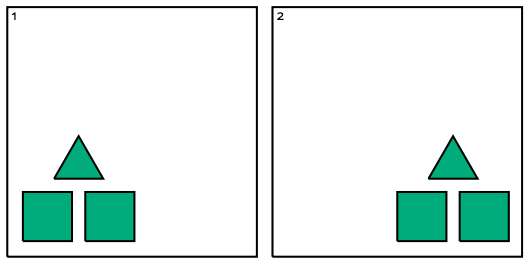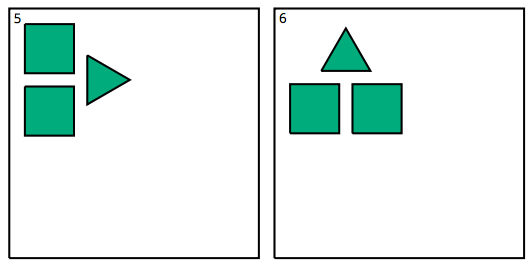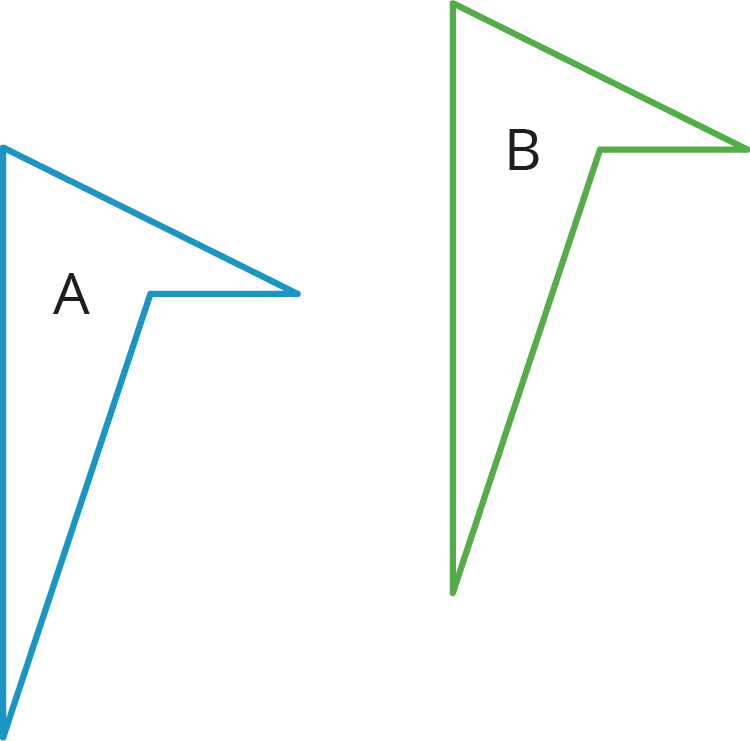Lesson 1
Moving in the Plane
1.1: Which One Doesn’t Belong: Diagrams (10 minutes)
Warm-up
This warm-up prompts students to compare four images. It encourages students to explain their reasoning and hold mathematical conversations. It gives you the opportunity to hear how they use terminology and talk about characteristics of the images in comparison to one another. To allow all students to access the activity, each image has one obvious reason it does not belong. Encourage students to find reasons based on mathematical properties (e.g., Figure B is the only right angle). During the discussion, listen for important ideas and terminology that will be helpful in upcoming work of the unit. The activity also gives students an opportunity to find useful tools in their geometry toolkit.
Before students begin, consider establishing a small, discreet hand signal students can display to indicate they have an answer they can support with reasoning. This signal could be a thumbs up, or students could show the number of fingers that indicate the number of responses they have for the problem. This is a quick way to see if students have had enough time to think about the problem and keeps them from being distracted or rushed by hands being raised around the class.
As students share their responses, listen for important ideas and terminology that will be helpful in upcoming work of the unit, such as reference to angles and their measures.
Launch
Arrange students in groups of 2–4, and provide access to geometry toolkits. Display the figures for all to see. Ask students to indicate when they have noticed one that does not belong and can explain why. Give students 1 minute of quiet think time and then time to share their thinking with their small group. In their small groups, tell each student to share their reasoning why a particular question does not belong. Together, find at least one reason each question doesn't belong.
Student Facing
Which one doesn’t belong?

Student Response
For access, consult one of our IM Certified Partners.
Activity Synthesis
Ask each group to share one reason why a particular image does not belong. Record and display the responses for all to see. After each response, ask the class if they agree or disagree. Since there is no single correct answer to the question of which one does not belong, attend to students’ explanations and ensure the reasons given are correct.
During the discussion, prompt students to explain the meaning of any terminology they use, such as ray, degree, or acute angle. Also, press students on unsubstantiated claims. For example, a student may make claims about the angle measures. Ask how they know the measure and demonstrate how the tracing paper or the ruler from the toolkit could be used to check.
1.2: Triangle Square Dance (25 minutes)
Activity
The purpose of this activity is for students to begin to observe and describe translations and rotations. In groups of 2, they describe one of 3 possible dances, presented in cartoon form, and the partner identifies which dance is being described. Identify students who use specific and detailed language to describe the dance and select them to share during class discussion.
While students are not expected to use precise language yet, this activity both provides the intellectual need for agreeing upon common language and give students a chance to experiment with different ways of describing some moves in the plane (MP6).
Launch
Arrange students in groups of 2, and give a copy of all 3 blackline masters to each group. Explain that each sheet is a cartoon with 6 frames showing the moves made by the dancing figures. Instruct students to place all three sheets face up, and tell them to take turns selecting a dance and describing it to their partner, without revealing which dance they have selected. The other student identifies which dance is being described. On a display, record language students use to describe the movement of shapes to later be grouped and connected to more formal language such as “rotation,” and “translation.” Give students 15 minutes to work in their groups followed by a whole-class discussion.
If using the digital activity, ask students to close their devices. Distribute the blackline masters and review the rules of the game to make sure students understand the task. Give students around 10 minutes to play the game. After 10 minutes, invite students to open their devices and notice how the applets correspond to the three dances. Give students an additional 5 minutes to come to consensus about how to best describe the moves in their own words before a whole-class discussion.
Supports accessibility for: Language; Memory
Student Facing
Your teacher will give you three pictures. Each shows a different set of dance moves.
-
Arrange the three pictures so you and your partner can both see them right way up. Choose who will start the game.
-
The starting player mentally chooses A, B, or C and describes the dance to the other player.
-
The other player identifies which dance is being talked about: A, B, or C.
-
-
After one round, trade roles. When you have described all three dances, come to an agreement on the words you use to describe the moves in each dance.
-
With your partner, write a description of the moves in each dance.
Dance A:
Dance B:
Dance C:
Student Response
For access, consult one of our IM Certified Partners.
Launch
Arrange students in groups of 2, and give a copy of all 3 blackline masters to each group. Explain that each sheet is a cartoon with 6 frames showing the moves made by the dancing figures. Instruct students to place all three sheets face up, and tell them to take turns selecting a dance and describing it to their partner, without revealing which dance they have selected. The other student identifies which dance is being described. On a display, record language students use to describe the movement of shapes to later be grouped and connected to more formal language such as “rotation,” and “translation.” Give students 15 minutes to work in their groups followed by a whole-class discussion.
If using the digital activity, ask students to close their devices. Distribute the blackline masters and review the rules of the game to make sure students understand the task. Give students around 10 minutes to play the game. After 10 minutes, invite students to open their devices and notice how the applets correspond to the three dances. Give students an additional 5 minutes to come to consensus about how to best describe the moves in their own words before a whole-class discussion.
Supports accessibility for: Language; Memory
Student Facing
Your teacher will give you three pictures. Each shows a different set of dance moves.
-
Arrange the three pictures so you and your partner can both see them right way up. Choose who will start the game.
-
The starting player mentally chooses A, B, or C and describes the dance to the other player.
-
The other player identifies which dance is being talked about: A, B, or C.
-
-
After one round, trade roles. When you have described all three dances, come to an agreement on the words you use to describe the moves in each dance.
- With your partner, write a description of the moves in each dance.
Student Response
For access, consult one of our IM Certified Partners.
Student Facing
Are you ready for more?
We could think of each dance as a new dance by running it in reverse, starting in the 6th frame and working backwards to the first.
-
Pick a dance and describe in words one of these reversed dances.
-
How do the directions for running your dance in the forward direction and the reverse direction compare?
Student Response
For access, consult one of our IM Certified Partners.
Anticipated Misconceptions
Some students may interpret directions like “left” and “right” different from how their partner intended it, depending on whether they are thinking from the point of view of an observer watching the dance or putting themselves in the dance and describing things in terms of the triangle’s left, right, up, and down. Watch for miscommunications like this, point out that neither perspective is wrong, and encourage students to be more precise in their language.
Students often confuse or are unsure about the meaning of the terms clockwise and counterclockwise. Discuss with them (and demonstrate, if possible) how the hands on a clock rotate, emphasizing the direction of the rotation. Students may also be unsure of how to describe the amount of rotation. Consider asking a student who expresses angle measures in terms of degrees to explain how they see it.
Activity Synthesis
Select one student to share their description for each of the pages, and display the language you observed and recorded during the activity for the different types of moves. Arrange the words in two groups, those that describe translations and those that describe rotations (but do not use these terms). Come to agreement on a word for each type, and discuss what extra words are needed to specify the transformation exactly (e.g., move right, turn clockwise 90º).
Consider asking students what they found most challenging about describing the dances: expected responses include being as precise as possible about the different motions (for example, describing whether the shape is rotating clockwise or counterclockwise). Also consider asking students if they were sometimes able to identify the dance before their partner finished describing all of the moves. All three dances begin by moving to the right, but in the second step, Dances A and B rotate 90 degrees clockwise while Dance C rotates 90 degrees counterclockwise. (So if the second move was to rotate 90 degrees counterclockwise, this must be Dance C.) Dances A and B diverge at slide 4.
Design Principle(s): Support sense-making
Lesson Synthesis
Lesson Synthesis
We have started to reason about what it means to move a figure in the plane. Display two figures that clearly show a slide and two figures that clearly show a turn. Example of a slide:


Invite students to share the language they would use to describe them: for example “moving” or “sliding” for translations and “turning” for rotations. Consider asking students how they might quantify each move, for example with a distance and direction for the slides and a center and angle of rotation for the turns. Tell them that we will continue to look at these moves in more detail in future lessons.
1.3: Cool-down - Frame to Frame (5 minutes)
Cool-Down
For access, consult one of our IM Certified Partners.
Student Lesson Summary
Student Facing
Here are two ways for changing the position of a figure in a plane without changing its shape or size:
- Sliding or shifting the figure without turning it. Shifting Figure A to the right and up puts it in the position of Figure B.

- Turning or rotating the figure around a point. Figure A is rotated around the bottom vertex to create Figure C.
